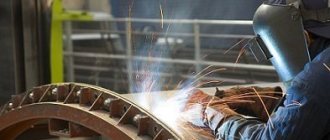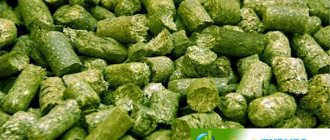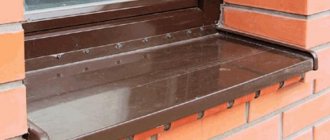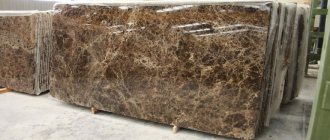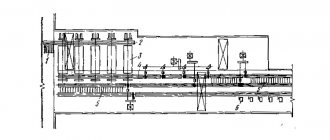4.3
Average rating: 4.3
Total ratings received: 194.
4.3
Average rating: 4.3
Total ratings received: 194.
Permanent magnets are bodies that can retain the ability to attract metal objects for a long time. What underlies this amazing property, how does a magnetic field arise, what substances can have such properties? Let's try to figure it out.
From the history of magnetism
In the VI century. BC. In ancient China, a mineral (rock) was discovered that attracted iron objects. The Chinese gave it the name “chu-shi”, which translates as “loving stone.” “Loving” - in the sense of attracting.
The word “magnet” was introduced into use by the ancient Greeks in the 5th century. BC. There is a legend that the first samples of these unusual “black stones” were found near the city of Magnesu, where deposits of magnetite were discovered. Magnet is translated as “stone from Magnesia”.
Magnetite is a black iron ore mineral, iron oxide Fe3O4, which has natural magnetic properties.
Finding a customer will be easy
Manufacturing magnets as a business has certain requirements. First of all, they relate to the sale of products. But finding customers who can purchase a wholesale batch of magnets is not very difficult. The entire complexity of this process lies in the need to predict this or that corporate event.
Magnets have always been popular at various exhibitions, as they are capable of carrying a certain logo. But even if there is no customer for a wholesale batch, you can always produce single products.
Definition and main features of a permanent magnet
A permanent magnet is a solid object that can maintain a state of magnetization for a long time. The state of magnetization means the presence of a magnetic field that affects (attracts) metal objects.
Permanent magnets can be of natural origin (magnetite) or artificial, which are made from iron, steel, nickel, cobalt and other rarer metals. Artificial magnets are obtained by magnetizing workpieces in a strong magnetic field. These magnets can come in different shapes and sizes.
Rice. 1. Permanent magnets of different shapes. Strip and arc magnets
The main feature of a permanent magnet is the presence of two magnetic poles: the south - S, and the north - N. Magnetic lines are directed outside the permanent magnet from the north pole to the south, and inside the magnet from south to north.
Polarity
All magnets have two poles: north and south. They always exist in pairs. Even if you divide the magnet into two even parts, both will have two poles.
The north and south poles are observed in pairs. If you try to separate them, you will only increase the number. As a result, you will reach an iron atom with poles that cannot be separated
Why does a permanent magnet have a magnetic field?
In 1820, the Danish physicist Hans Oersted, while studying electrical phenomena, discovered that if a magnetic compass needle was placed near a metal wire, then when the electric current was turned on, the needle deviated by a noticeable angle. Although he could not explain this phenomenon, after the publication of these results, the French scientist Andre-Marie Ampère suggested that the movement of electric charges in a wire - an electric current - leads to the appearance of a magnetic field. Interaction occurs and in practice the needle is deflected.
Rice. 2. Ampere's hypothesis. Ampere's model for internal currents in magnets
Ampere used the same idea to explain the nature of the magnetic field of permanent magnets. According to his theory, the magnetic field appears due to the presence in magnets of continuously circulating circular currents, which are equivalent to small magnets. These currents add up, reinforce each other and create a common magnetic field inside and outside the magnet. A magnet as a whole is a set (sum) of these magnets.
Our planet is a huge permanent magnet. The schematic diagram of the Earth's permanent magnet, which creates its magnetic field, is similar to the nature of an ordinary, natural magnet. The Earth's core has an outer shell of molten metals (iron, nickel and a number of impurities) at a temperature of more than 4000 K0. The hot mass, consisting of a mixture of charged particles, rotates along with the Earth. As a result, continuously circulating flows and vortices arise, which are the main reason for the appearance of the Earth's magnetic field.
Room
The workshop for the production of permanent magnets must be clean, spacious, and well lit. It must support the following conditions:
- low air humidity;
- temperature ranging from 18ºC to 24ºC.
The area depends on the number and dimensions of the installed equipment - for the location and free maintenance of one production line, at least 60 square meters are required. m.
In addition, you will need to allocate space for storage for raw materials and magnets. Here the requirements are different - to store finished products, the room must be completely dry, otherwise they will oxidize and disintegrate. Neodymium magnets should be placed at a distance of half a meter from each other or special separators should be placed between them.
Taking into account the need to arrange an office, utility rooms and service rooms, a mini-factory for the production of permanent magnets will require a building with an area of 100 sq.m. It is desirable that it be located in an industrial zone, have convenient access and parking.
To organize a mini-workshop for the production of souvenir and advertising magnets of these types, you will need a room measuring 20 square meters. m. This area should be enough to arrange the following areas:
- production workshop – 10 sq. m;
- office and utility rooms - 5 sq. m;
- warehouses – 5 sq.m.
There are no special requirements for the premises, everything is within the general standards.
How and what are permanent magnets made from?
Magnetites have rather weak magnetic properties. Industrial mass production of artificial magnets of various sizes has been established. The starting materials for this are alloys based on metals: iron Fe, nickel Ni, cobalt Co, neodymium Nd, samarium Sm. Blanks from these alloys are produced by casting, pressing or sintering. They are then placed in a very strong, uniform magnetic field created by electromagnets. When exposed to a magnetic field, magnetized particles are directed in one direction. This aligns the polarity of the future magnet. As a result, the workpieces are strongly magnetized and become independent permanent magnets.
Recently, polymer permanent magnets (magnetoplasts) have gained great popularity. They are made from a mixture of magnetic powder and a polymer (plastic) elastic additive, such as rubber. The magnetic properties of magnetoplasts are low, but they are quite sufficient for the manufacture of various useful devices, for example, refrigerator magnets, plastic cards, demonstration and educational boards.
Financial calculations
An enterprise for the production of magnets or products made from them can have a variety of sizes. When producing souvenir and advertising magnetic products, the most profitable will not be home production, but at least a minimum-sized workshop, organized in accordance with all the rules of doing business and producing about 20,000 products per month. A small plant for the production of permanent magnets can produce an average of 1000 kg of products monthly. As an example of financial calculations, we consider such an enterprise for the production of neodymium magnets.
Starting investments
To organize a business, you will need special equipment, the cost of which will make up the bulk of the initial investment.
The production of neodymium magnets requires the purchase of the following equipment:
| Name | Cost, rubles |
| Induction oven | 110500 |
| Ball chopper | 19500 |
| Linear/isostatic press | 325000 |
| Sintering furnace | 35000 |
| Grinding machine | 30000 |
| Annealing furnace | 25000 |
| Induction unit | 55000 |
| Coating Device | 100000 |
| Total | 700000 |
To produce magnetic products you will need:
| Name | Cost, rubles |
| Laptop | 20000 |
| Inkjet photo printer | 30000 |
| Vinyl cutting machine | 30000 |
| Magnet rolling machine | 12000 |
| Laminator | 25000 |
| Laser engraver | 15000 |
| Metal detector | 25000 |
| Total | 157000 |
The next cost item is the purchase of raw materials and supplies. To produce 1000 kg of neodymium magnets, 1450 kg of NdFeB powder is required, the wholesale cost of which is 400,000 rubles.
The monthly requirement for consumables for magnetic products will be as follows:
| Name | Unit price, rubles | Quantity | Total cost, rubles |
| Color cartridge | 3000 | 1 | 3000 |
| Photo paper, sheet A4 | 10 | 50 | 500 |
| Vinyl magnetic tape, 30 m roll, 0.6 m wide | 5000 | 1 | 5000 |
| Lamination film, sheet A4, thickness 125 microns | 5 | 100 | 500 |
| Wood (plywood), sheet 1 sq. m. | 500 | 10 | 5000 |
| Disc-shaped magnets CMD-02 Mr.Painter ferrite | 10 | 300 | 3000 |
| Consumables (varnish, glue) | 1000 | ||
| Total | 18000 |
The total costs of starting a business will be:
| Cost item | Amount, rubles | |
| Magnets | Magnetic products | |
| Preparing the premises: warehouse and office equipment rent for the duration of the work | 200000 100000 100000 | 40000 10000 30000 |
| Equipment purchase | 700000 | 157000 |
| Purchase of a month's supply of raw materials | 400000 | 18000 |
| Advertising and marketing campaign | 50000 | 10000 |
| Unexpected expenses | 50000 | 20000 |
| Total | 1400000 | 245000 |
Monthly expenses
The production of magnets requires large monthly investments. In addition to purchasing raw materials, it will be necessary to spend considerable sums on labor costs. For the specified staffing table, the payroll will be:
| Job title | Salary, rubles | Number of units | Payroll, rubles |
| Director | 40000 | 1 | 40000 |
| Chief technologist | 35000 | 1 | 35000 |
| Purchasing Manager | 30000 | 1 | 30000 |
| Sales manager | 30000 | 1 | 30000 |
| Accountant | 35000 | 1 | 35000 |
| Line operator | 35000 | 4 | 140000 |
| Helper workers | 20000 | 2 | 40000 |
| Total | 350000 |
The production of magnetic products has low operating costs. When hiring three employees and provided that the entrepreneur takes over the functions of the manager, the wage fund will be:
| Job title | Salary, rubles | Number of units | Payroll, rubles |
| Accountant | 40000 | 0,5 | 20000 |
| Specialist | 25000 | 1 | 25000 |
| Manager | 25000 | 1 | 25000 |
| Total | 70000 |
In general, monthly expenses for both types of businesses will be:
| Cost item | Amount, rubles | |
| Permanent magnets | Magnetic products | |
| Rental of premises | 100000 | 30000 |
| Purchase of a month's supply of raw materials | 400000 | 18000 |
| Payroll | 350000 | 70000 |
| Advertising and marketing campaign | 20000 | 2000 |
| Unexpected expenses | 30000 | 10000 |
| Total | 900000 | 130000 |
Planned profit
Using the specified equipment and the amount of raw materials, it will be possible to produce 1000 kg of magnets or 20,000 magnetic products per month. The calculation of financial results will be as follows:
| Index | Value, rubles | |
| Permanent magnets, 1000 kg/month | Magnetic products, 20,000 pieces/month | |
| Average selling price of 1 unit | 2000 | 20 |
| Revenue for the month | 2000000 | 400000 |
| Profit before tax | 1100000 | 270000 |
| Tax (USN, 6% of income) | 66000 | 24000 |
| Net profit | 1034000 | 246000 |
Based on the indicated performance indicators, the invested funds in both options for doing business will conditionally pay off in 1–2 months of full-time work. But if we take into account that any enterprise will reach the full volume of production and sales of its products in six months at best, then the payback period will be approximately 7–8 months.
The main condition for successful work is reliable sales channels. Therefore, it is necessary to engage in an advertising campaign and establish cooperation with potential buyers at the stage of organizing a business. Then it will be truly profitable and promising.
Where are permanent magnets used?
The remarkable properties of permanent magnets are used in various fields of science, technology, production, and in everyday life. Here are just a few of them:
- Recording and storing information (magnetic tapes, computer floppy disks and disks);
- Plastic cards for various purposes (financial, bonus, access control);
- Microphones, loudspeakers, sound equipment;
- Electric motors, generators, transformers;
- Compasses;
- In measuring instruments with a deflecting pointer, for example, in ammeters;
- Plastic magnets for use in educational exhibition purposes;
- Fridge magnets;
- Making fasteners for clothes and bags:
- Furniture clamps (closing doors);
- Kids toys.
Rice.
3. Areas of application of permanent magnets/p> The palm among the most powerful artificial magnets today is held by magnets that include rare earth metals: neodymium (Nd-Fe-B alloy) or samarium (Sm-Co alloy). These magnets can maintain their properties without demagnetization for 30 years.
Legal registration
Organizing a plant for the production of permanent magnets requires registration of a legal entity with the establishment of an LLC. The application must indicate the following OKVED codes:
- main – 25.99 – “Production of other finished metal products not included in other groups”, including the production of permanent metal magnets;
- additional – 23.44 – “Production of other technical ceramic products”, including the production of ceramic and ferrite magnets.
Permanent magnets of any type must be produced in compliance with the requirements of the following GOSTs:
- 25639-83 “Cast permanent magnets. Technical conditions";
- 24936-89 “Permanent magnets for electrical products. General technical requirements";
- 17809-72 “Hard magnetic cast materials. Marks";
- 18321-73 (ST SEV 1934-79) “Statistical quality control. Methods for random selection of samples of piece goods.”
It is not required to obtain a license or certificate for the manufacture of permanent magnets, but it is recommended to undergo voluntary certification to confirm the quality of the product.
The production of magnetic products is not a large-scale project, so such activities can be carried out as an individual entrepreneur (IP). When choosing an OKVED code, you should focus on the type of product being manufactured. The following codes are suitable for this activity:
- 23.44 – “Production of other technical ceramic products”, including the production of ceramic and ferrite magnets;
- 32.40 – “Production of games and toys”;
- 22.29 – “Production of other plastic products”;
- 17.29 – “Production of other products from paper and cardboard”;
- 18.12 – “Other types of printing activities, including printing directly on textiles, plastic, glass, metal, wood and ceramics.”
When producing magnetic products, it is necessary to comply with the standards of other GOSTs:
- R 51715-2001 “Decorative and souvenir products, similar in external structure to bladed or throwing weapons. General technical requirements";
- 25779-90 “Toys. General safety requirements and control methods";
- R 53906-2010 “Toys. General safety requirements and test methods. Mechanical and physical properties";
- 32583-2013 “Cutlery and kitchen utensils made of corrosion-resistant steel. General technical conditions";
- R 51687-2000 “Cutlery and kitchen utensils made of corrosion-resistant steel. General technical conditions".
Some magnetic products, in particular toys and kitchen utensils, may be subject to mandatory certification. Souvenir products are certified on a voluntary basis.
Absence of any competition
It is also worth noting that this entrepreneurial idea will be successful because there is no competition in this field of activity. The market is not saturated with souvenirs of this kind, and in some cities an entrepreneur is even capable of becoming a monopolist. The not very high cost of all products will allow you to make a profit that will significantly exceed all initial costs. That is why this business is considered highly profitable.
To summarize all of the above, it can be noted that for the first time the entrepreneur will need approximately 50 thousand rubles. But this entire amount will be fully paid off in two months, or even earlier.
How much do you need to save in exchange for a discount?
| Product (name + photo) | Retail price, rub | Discount price, rub | Number of stickers, pieces |
| Paring knife 8.4 cm | 1299 | 299 | 20 |
| Utility knife 12.6 cm | 1499 | 349 | 20 |
| Chopping knife 19.4 cm | 2199 | 599 | 20 |
| Cook's 19.6 cm | 2999 | 599 | 20 |
| Santoku 17.9 cm | 2499 | 699 | 20 |
| Steak set 2 pcs | 2999 | 699 | 20 |
| Kitchen hatchet | 2499 | 799 | 20 |
| Kitchen scissors | 999 | 299 | 20 |
| Stand 7.8 x 17 x 23 cm | 1999 | 799 | 20 |
| Double-sided whetstone | 1499 | 599 | 20 |
| Cutting board 35 x 25 x 1.5 cm | 1999 | 699 | 20 |
Directionality of the electromagnetic field
You've probably noticed that magnetic objects often attract iron not with their entire area, but with a certain side. Plus, if you try to connect two such objects together, they can repel each other, and a neodymium magnet (ndfeb) is no exception in this regard. The reason is the type of magnetization, which is formed at the initial stage of production and can be axial, diametrical and radial.
If we consider a disk as an example, we will see that its poles are located on the upper and lower flat surfaces, while for diametrical devices they are on the curved side surface. Finally, what a neodymium magnet with radial magnetization means can be better seen using the example of a ring. The poles here are located along the outer convex surface and along the inner one.
Advertising activity
In order to attract potential customers and interest them in your products, it is best to create a business card website. In addition, advertisements can be placed on other portals of similar topics. Advertising activities on a large scale are not advisable, since the company will be engaged in wholesale sales. You can also advertise your activities through supermarkets, selling some of the magnets with their help.
Selling magnets can bring quite high profits. Therefore, it makes sense to try hard to ensure that your income is very high.
What is needed to produce a magnet?
In order to organize a business, you do not need any specialized equipment for making magnets. You just need a computer. As for software, you need to purchase and install any graphic editor. You will also need an inkjet printer, die cutter and batch laminator. The procedure for manufacturing magnetic products takes place in six steps.
- You will need to print an image on transparent plastic with hot-melt adhesive, having first mirrored it in the editor.
- The transparent plastic on which the design is applied must be separated from the substrate and turned over.
- The resulting material must be passed through a laminator.
- The backing that protects the adhesive layer should be separated from the sheet.
- The sheet with the design printed on it will need to be glued onto vinyl.
- The resulting products must be cut down.
There is nothing complicated in the manufacturing procedure. The images can be absolutely anything. You just have to take into account the fact that instead of paper you need to use a transparent material - plastic.
Based on all of the above, it can be noted that the entire procedure will not require too much free time. But at the same time, you can get magnets with any picture and various shapes. The thickness of such products can reach only one and a half millimeters, but the magnets will be quite strong.

